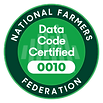EAP Partners
These organisations use the AIA Environmental Accounting Platform to power their on-farm GHG emissions calculations. Find out how you can too - for free*! >
Free API access to the EAP calculation engine available now
The EAP is a powerful, science-backed engine for calculating on-farm greenhouse gas emissions across a wide range of agricultural, fisheries, and aquaculture commodities.
Aligned with the Greenhouse Accounting Framework (GAF) Tools for Australian Primary Industries, the EAP will transition to the Australian Government’s forthcoming voluntary emissions and reporting standards for agriculture, fisheries, and forestry once they are available.
The EAP is accessible via an application programming interface, or API.
Why integrate with the EAP API?
Whether you're building tools, calculators or digital services for producers, or calculating emissions for your organisation or undertaking research, the EAP API offers:
-
Trusted, consistently updated emissions calculators maintained by AIA
-
Backed by industry - built with investment from10 rural Research and Development Corporations
-
Supported by a panel of Australia’s leading experts
-
Coverage across 15+ commodities
-
A simple, developer-friendly API for easy integration
-
Free access until June 2028 to support industry-wide consistency.
Free access to AIA’s API is supported by the Australian Government
through funding from the Improving Consistency of On-Farm
Emissions Estimates Program.

Who should use it?
-
Industry service providers
-
Agtech developers
-
Supply-chain organisations
-
Sustainability consultants/advisors
-
Financial institutions
-
Researchers
-
Corporate agriculture businesses
If you're developing tools that require accurate, consistent GHG emissions calculations at the farm level, the EAP API is built for you.
Get started
Ready to start using the EAP API? Check that you:
-
are an authorised representative and can accept the API access terms and conditions on behalf of your organisation
-
have generated a Certificate Signing Request (CSR) to upload
-
have contact details for a technical representative from your organisation for communications about the API.
If you answered yes to these questions, complete this simple form to get started.
The On-Farm Carbon Advice project is building knowledge and capability of carbon farming practices in NSW extensive beef, sheep, dairy, and mixed farming systems. It uses AIA's EAP to support participating producers calculate their on-farm emissions. More >
The Carbon Farming Outreach Program is here to assist Victorian farmers to understand their emissions and the benefits of carbon farming. Working together with Agriculture Victoria and the ten regional Catchment Management Authorities, this program is delivering training in local areas tailored to audiences. More >

The EAP was one of the first ten products or services awarded certification under the Australian Farm Data Code. The Code was developed by the NFF and aims to promote adoption of digital technology by ensuring that farmers have comfort in how their data is used, managed and shared. More >
Latest updates to the EAP
The AIA Environmental Accounting Platform (EAP) is regularly updated to reflect changes to the National Greenhouse Accounts emissions factors, based on recommendations from the EAP Technical Advisory Panel . The Panel, made up of leading Australian experts in GHG accounting, emissions reductions, soil carbon management and climate science, ensures the AIA EAP remains on the cutting edge of science and research and stays up-to-date with relevant standards.
18 September 2024
This update includes emissions factor changes as per the below. In addition, this update means the EAP is already consistent with the very latest versions of the GAF Tools - which will be published on the Primary Industries Climate Challenges Centre website shortly.
Emissions Factor Changes
The two emissions factor changes that are now live in the EAP are:
-
The crop residue emission factor has been updated to 0.503%
-
The nitrous oxide emission factors for inorganic fertiliser have been updated to:
Production system
Irrigated pasture
Irrigated crop
Non-irrigated pasture
Non-irrigated crop
Sugar cane
Cotton
Horticulture
Emission factor (a) (Gg N2O-N/Gg N)
0.0059
0.007
0.0018
0.0041(b)
0.0199 (c)
0.0053
0.0064
(a) Based on (Grace, et al. 2023)
(b) Weighted EF assuming 77 percent of non-irrigated crops occur on low rainfall areas. Low rainfall EF=0.0029 and high rainfall EF=0.008. The threshold between low and high rainfall areas is annual rainfall = 600mm.
(c) Based on Scherbak and Grace (2014).















